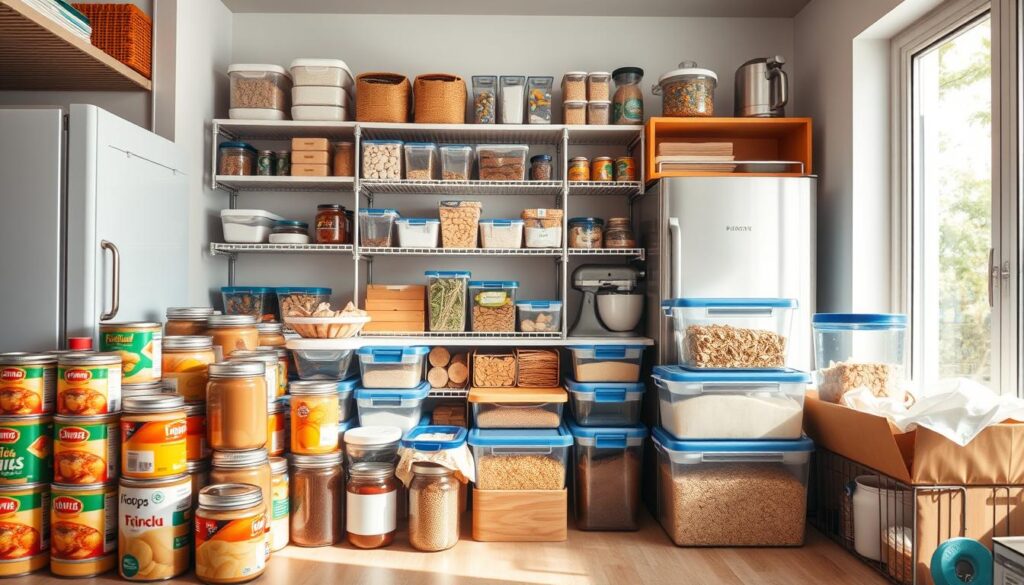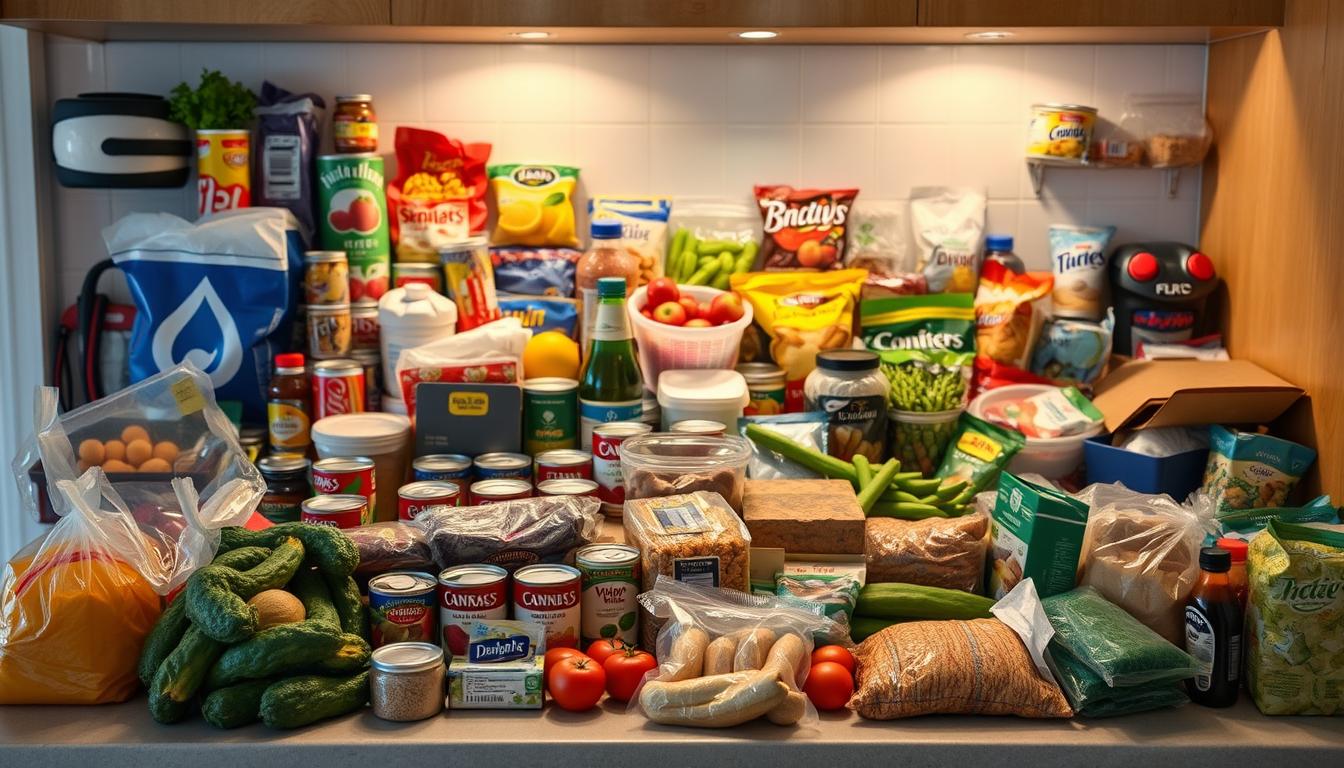Grocery Shopping for a Month: Planning your monthly grocery shopping can really help your budget and daily life. By making a shopping list and knowing what you use, you can cut down on waste and save cash.
Imagine having everything you need in your pantry and fridge, ready to go. No more running to the store all the time. This guide will show you how to get ready for monthly grocery shopping. It’s all about making your life easier and saving money.
By the end of this guide, you’ll know how to shop smarter. Your shopping will be faster and cheaper.
Contents
- 1 Benefits of Monthly Grocery Shopping
- 2 Planning Before You Shop
- 3 Creating a Monthly Grocery Budget
- 4 How to Grocery Shop for a Month: Creating Your Master List
- 5 Shopping Strategies for Bulk Buying
- 6 Food Storage Solutions
- 7 Monthly Meal Planning Strategies
- 8 Conclusion: Grocery Shopping for a Month
- 9 FAQ
Benefits of Monthly Grocery Shopping
Monthly grocery shopping can make your life easier and save money. Buying in bulk means fewer trips to the store. This saves fuel and time. It also helps you stay within your grocery budget and avoid impulse buys.
Reducing Waste
Buying in bulk also cuts down on waste. You can store more food properly, so it doesn’t go bad. Good storage and planning help reduce food waste.
| Benefits | Description | Impact |
|---|---|---|
| Bulk Buying | Buying larger quantities | Saves money, reduces trips to the store |
| Grocery Budgeting | Planning expenses | Reduces impulse buys, saves money |
| Waste Reduction | Proper storage and planning | Less food waste, more savings |
Monthly grocery shopping offers many benefits. It’s about being smart with what you buy and use. This way, you can save money and reduce waste.
Planning Before You Shop
To get the most from your grocery trip, planning meals ahead is key.Effective meal planning lets you know what you need. This way, you avoid buying too much and wasting food.
Checking What You Already Have
First, see what you already have at home. Look in your pantry, fridge, and freezer. This helps you not buy things you already have.
Here’s a simple table to help you organize your inventory:
| Item | Quantity | Expiration Date |
|---|---|---|
| Rice | 2 bags | 12/2024 |
| Canned Beans | 5 cans | 06/2025 |
By planning meals and checking what you have, you’ll make a better grocery list. This saves money and cuts down on waste. Start planning your meals today for a better grocery trip.
Creating a Monthly Grocery Budget
Having a monthly grocery budget keeps your spending in check. It stops you from spending too much. To make a good budget, you must know how you spend money and find ways to save.
Allocating Funds
When setting up your grocery budget, think about these categories:
- Fresh produce
- Meat, poultry, and seafood
- Dairy products and eggs
- Canned and packaged goods
- Snacks and beverages
Put a percentage of your budget into each category. This depends on what you like to eat and your family size. For instance, a big family might need more for meat and seafood.
To get the most from your grocery budget, keep track of what you spend. This shows where you can cut costs. Being smart about your shopping helps you save money.
By following these steps, you can make a budget that works for you. It will help you save money and meet your needs.
How to Grocery Shop for a Month: Creating Your Master List
To efficiently grocery shop for a month, start with a well-organized master list. This list will guide you through the store. It ensures you don’t miss out on essential items.
Prioritizing Essentials
When making your master list, focus on the essentials first. Organize your list into sections like produce, dairy, meats, and pantry staples. This makes shopping easier and more organized.
| Category | Examples | Tips |
|---|---|---|
| Produce | Fruits, Vegetables | Buy in season for freshness and savings |
| Dairy | Milk, Cheese, Yogurt | Check expiration dates |
| Meats | Chicken, Beef, Fish | Consider buying in bulk and freezing |
Prioritizing essentials means focusing on what you use most. This helps you save money by avoiding unnecessary buys.
By following these steps and creating a detailed master list, you’ll be ready for efficient monthly grocery shopping.
Shopping Strategies for Bulk Buying
Consider using bulk buying strategies for your monthly grocery shopping. It’s a cost-effective way to buy groceries. But, you need to plan well to get the best deals and use your storage space wisely.
Buying in bulk has its pros and cons. It can save you a lot on non-perishable items, household essentials, and personal care products. However, it means spending a lot upfront and having enough space to store things.
You can find bulk groceries at many places, both online and in stores. Here are some good options:
- Warehouse clubs like Costco and Sam’s Club
- Online retailers like Amazon and Boxed
- Specialty stores that focus on bulk foods, such as Bulk Apothecary
- Local co-ops or buying clubs
When shopping for bulk groceries, check the prices per unit to find the best deal. Also, think about the product’s shelf life and your storage space to avoid waste and save money.
By using these strategies, you can save money, reduce waste, and enjoy your monthly grocery shopping more.
Food Storage Solutions
Keeping your groceries fresh for longer is key. This helps you enjoy your food more and waste less. When you buy in bulk, the right storage is crucial.

Airtight containers are a great way to store food. They keep air, moisture, and pests out. This keeps your groceries fresh. Use them for dry goods like pasta, rice, and cereals.
Maintaining Freshness
For perishable items, the right storage is essential. Freezer bags or airtight containers work well. They keep meat, vegetables, and fruits fresh longer.
Labeling these containers with the storage date is helpful. It lets you know how long you’ve stored them.
| Food Item | Storage Method | Expected Freshness Duration |
|---|---|---|
| Dry Goods (Pasta, Rice) | Airtight Containers | Up to 12 months |
| Meat, Vegetables, Fruits | Freezer Bags/Airtight Containers | Several months to a year |
| Canned Goods | Cool, Dry Place | Up to 2 years or more |
Using these food storage solutions can greatly reduce waste. You’ll enjoy your groceries for longer. Just pick the right storage for each type of food.
Monthly Meal Planning Strategies
Monthly meal planning can cut down on food waste and save money. It helps you use up all your groceries before they go bad. This method also keeps your kitchen organized and your cooking schedule on track.
To begin meal planning, first check what you have in your pantry, fridge, and freezer. This way, you won’t buy things you already have. Then, plan your meals using ingredients that are close to expiring or on sale.
Incorporating Leftovers
Using leftovers is a big part of meal planning. You can have a “leftover day” in your meal plan or get creative with leftovers. For instance, leftover chicken can become chicken salad or soup. Being creative with leftovers not only reduces waste but also adds variety to your meals.
Here are some tips for effective meal planning:
- Plan around sales and seasonal produce.
- Use a meal planning app or calendar to stay organized.
- Make a grocery list based on your meal plan to avoid impulse buys.
- Consider batch cooking and freezing meals for later use.
By using these strategies, you can make the most of your grocery shopping. You’ll reduce waste and enjoy a varied meal plan all month long.
See Also: Affordable All-Inclusive Family Vacations Under $500
Conclusion: Grocery Shopping for a Month
You now know how to shop for groceries for a month. With a good plan, budget, and storage, you’re ready to make your shopping easier.
For success in monthly grocery shopping, make a master list, shop wisely, and plan your meals. This way, you’ll cut down on waste, save money, and always have groceries on hand.
As you start using these tips, you’ll get better at shopping for a month. You’ll learn to adjust to new situations and make changes when needed. Soon, shopping for a month will feel natural, saving you time and stress.
By following this guide, you’ll improve your grocery shopping experience. You’ll enjoy the benefits of shopping for a month.
See Also:
FAQ
How do I start planning my monthly grocery shopping?
How do I create a monthly grocery budget?
What are the benefits of buying groceries in bulk?
How do I store groceries to maintain their freshness?
Can I really save money by grocery shopping for a month?

Hi, I’m Waverly Moon, creator of TipsToFeelBetter.com. This blog is for practical moms and family-focused women seeking simple, realistic ways to improve daily life. From home routines to self-care, I share tips that truly work—because life doesn’t need to be perfect to feel better. Let’s make everyday moments a little easier, together.

